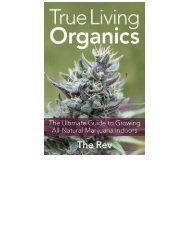Create successful ePaper yourself
Turn your PDF publications into a flip-book with our unique Google optimized e-Paper software.
THE KEY TO A PERFECT TLO LIVING TEA<br />
<strong>The</strong>re is no single tea recipe I could give you that would be “the best” because they are<br />
either living teas or they are not living teas. Now there are a couple ways <strong>to</strong> go about<br />
this, and if you have something like Great White microlife inoculate, you can sprinkle a<br />
very (very) tiny amount of this in<strong>to</strong> the tea, and the bacteria in this product will colonize<br />
the tea. What you are missing in this type of a tea is diversity, including things like<br />
nema<strong>to</strong>des, pro<strong>to</strong>zoa, and others. Fresh water fish aquariums are another great source of<br />
some diverse microlife and a small amount of this type of water can be added before<br />
your tea “brews” as well; as long as the fish are all healthy and chemical free.<br />
Making (or brewing/bubbling as I also call it) living teas for your TLO garden is a snap!<br />
<strong>All</strong> you need is an inexpensive aquarium air pump (Walmart $13.00 USD) some air<br />
tubing/line, an air s<strong>to</strong>ne and a container for bubbling in. This container should be opaque<br />
if possible. You can use teas every other time you water if you want <strong>to</strong>, as long as they<br />
aren’t <strong>to</strong>o crammed full of liquid nutrients.<br />
<strong>The</strong> following are a few “don’t do” type pieces of advice:<br />
• Avoid using anything but good pure water when making your teas (chlorine/chloramine<br />
free).<br />
• Don’t go insane using <strong>to</strong>o much kelp/seaweed, and/or molasses because overdosing is<br />
fairly easy.<br />
• Don’t overload with liquid nutrients. This is the number one issue most beginners<br />
have.<br />
• When applying your teas <strong>to</strong> the plants make sure <strong>to</strong> stir up the tea between each plant <strong>to</strong><br />
ensure even distribution of all the nutrient rich particles; these particles will fall <strong>to</strong> the<br />
bot<strong>to</strong>m quickly.<br />
• You can bubble your teas 24 hours <strong>to</strong> 72 hours at least, but don’t make a habit of going<br />
much longer, because as the food runs out many of the good microbeasties will die off.<br />
• Don’t forget <strong>to</strong> scrape down the sides of your tea bubbling container before using the<br />
tea because bacteria love <strong>to</strong> stick <strong>to</strong> things; it is what they do. I love my Betty Crocker<br />
frosting spatula for this job.<br />
<strong>The</strong> following is a partial list of great tea additions, in per gallon of water amounts:<br />
• ½–1 cup of living earthworm castings<br />
• ¼–½ cup of Big Bloom liquid bloom nutrient by Fox Farm<br />
• 1 tablespoon of kelp meal and/or alfalfa meal<br />
• 1–3 teaspoons of liquid fishy fertilizer (I like Organic Gem, & General <strong>Organics</strong><br />
brands here)<br />
• 1 teaspoon dry bird or bat guano (high nitrogen varieties are best)<br />
• 1–3 teaspoons of liquid molasses (all natural and unsulphured)



